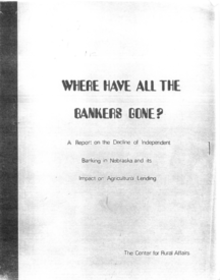As an independent banker who has been outspoken on banking matters for many years, I am pleased to present for the consideration of the public as well as the banking industry, this report on the impact of bank ownership on farm credit in Nebraska.
Although the report represents the first stage of a continuing study, it brings to light new information and provides fresh analysis of the branch banking controversy which has divided the banking community in Nebraska for so long. Although many of us who are bankers--including myself--may disagree with some of the findings of this report, we will find it difficult to dispute the central message offered by it: the banking industry is too vital to the agricultural economy of Nebraska to be left exclusively to bankers.
This report is also significant because it represents an "outsider's" view of banking. It has been prepared by people whose perspective on banking is critical, who are interested in a practical evaluation of its performance in rural communities. Moreover, preparation of the report has been guided by a committee of the Center for Rural Affairs board of directors composed of a farmer, a newspaper editor and an economist, a diverse group of non-bankers with a genuine interest in the banking business.
For me, one of the most important findings of this report is that there are fewer purely "independent" banks left in Nebraska than many of us had imagined. The report documents that a large number of banks are in the grey area between being independent and being parts of larger bank groups. In fact, I note from the classification of banks in the appendix of this report, that only a minority of the members of the board of directors of Nebraskans for Independent Banking, Inc., are from purely independent banks. This does not imply to me any sort of conspiracy, nor does it mean that these "non-independents" are not supporters of independent banking. It simply says that the banking industry is undergoing a sort of crisis of identity, and provides a clear explanation for the erosion of independent bank consciousness which has been underway for many years. The truly independent bank has lost its prominence in an industry which is undergoing rapid concentration.
I hope that this report adds to the public understanding of this issue, and that as a result, public judgements about the future of the banking industry can be made on the basis of better information than they have been in the past.
The Center board of directors hopes, and intends, that this initial report will be followed by more thorough studies, and we invite the comments of the public and the banking community in helping to shape these further efforts.
V.E. Rossiter, Sr.
Hartington, Nebraska
March 1977


